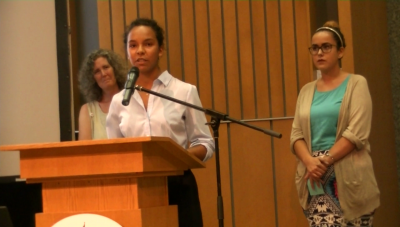The petition to create a new financial security, Nature Bonds (E-1264 – Protection of the Environment) must be signed online by 3:00pm, 23 March 2018.
Addressed to the inhabitants of Canada
On the following interesting subjects:
- A move to protect 90% of Canada’s land and aquatic area as a permanent natural reserve.
- A move to zero carbon by 2024.
- As funded by the creation of a new financial security; Nature Bonds.
2017 marked the one hundred and fiftieth anniversary of our nation. This same year also marks 35 years since the Canadian Charter of Rights and Freedoms came into effect. This is cause for celebration, but also a re-evaluation of what it means to be Canadian. What it means today to respect the ideals outlined by our forefathers.
I am thinking about the right to security of person, a right not only in our own country’s charter, but in the Universal Declaration of Human Rights.
Climate change, and the biodiversity crisis violate my generation’s (I’m seventeen) right to security of person as set out herein. Although the current government has taken unprecedented action on this issue, it will not suffice. It is a drop in the ocean of things that need to be done. Therefore I propose a very simple solution:
That we create a new financial security, Nature Bonds, in order to fund the protection of 90% of Canada’s land and aquatic area as a permanent natural reserve, and a move to net-zero carbon by 2024.
I understand that this is an incredibly ambitious goal, that this is a kind of previously unheard of action. However, “We meet in an hour of change and challenge, in a decade of hope and fear, in an age of both knowledge and ignorance. The greater our knowledge increases, the greater our ignorance unfolds” (Kennedy).
Everyone is susceptible to fear and ignorance, but we are stronger than that. We, as a compassionate and kind people, must come together to achieve the protection of the biosphere because if we fail, we betray every single generation to come. In six years the allied forces defeated both Hitler and Hirohito. In eight years humanity brought a man to the moon. We have had decades to counteract climate change and still no one has moved to do what must be done. Perhaps the ship has already sailed. But we must still try. A failure to do this would reflect cowardliness and an unprecedented failure of humanity when this generation and all generations to come need us most.
The goal to protect ninety percent of Canada’s land began with the knowledge of acclaimed biologist E.O.Wilson. He explains that, “The fraction of species that can be protected in one-half the global surface is about 85%. A biogeographic scan of Earth’s principal habitats shows that a full representation of its ecosystems and the vast majority of its species can be saved within half the planet’s surface. At one-half and above, life on Earth enters the safe zone.”
Canada has 9 985 000 square kilometres of land. When you combine the amount of arable land, permanent pastures, cities and other built-up land, the total occupied land is less than 10%. So, by that count we could easily protect 90% of Canada’s area— 8 986 500 square km.
Ninety percent makes sense because we must do more than we are doing now, as a country extremely gifted with space, and monetary resources. We must do more because other nations will be able to accomplish less. But truly, we must do more because it is the right and true thing to do.
I know that a good deal of land is already protected in Canada, through our national parks program, and other initiatives. This would just formalize and expand on what we have, and this 90% would include the parks and other currently protected areas. In addition, it is not my intention that people are forcefully relocated in order to create these protected areas.
The exact land that is protected should comprise of all the different ecological zones and regions in Canada, and as many different species as possible should be protected within this land. Sometimes, this will mean that areas such as roads will need to be temporarily closed, for example, during the migration of animals, in order to protect species.
Ninety percent should also apply to our coastlines, which are fragile and not well protected. 243,797 km of coastline, times the 360 km out that Canada claims, is 90 204 890 square km of ocean. If we include the great lakes’ 3800 km of coastline and all our smaller lakes, rivers, streams, etc. we have thousands more of square km of water to protect.
I propose that:
- This land and water will belong to all Canadian citizens.
- It is not allowed to be used for corporate gain for the next 30 years, to allow the area to regenerate to full health. At that point, a new discussion can begin on the topic of sustainably harvesting renewable resources.
- This protection means that all resources both underground and aboveground on the protected land will remain where they currently are.
- Aboriginal citizens will be allowed to harvest what they need in small and reasonable amounts for personal use, and all citizens who are camping or whatnot should be able to do the same.
- This land is to be maintained and restored so that it is as healthy and diverse as possible.
- It is to be extensively researched so that we better understand the nature of the ecosystems and wildlife that comprise it.
- All Canadians are allowed to inhabit this land on temporary and net-zero carbon structures.
As for climate change, in order to meet the Paris targets, we must aim to be carbon neutral by 2024. Most of our target dates are set for 2030, and so we only have to shorten the timeline by six years. If we do not aim for 2024, we will most likely not succeed in staying below 2 degrees of warming, the models show us. The government of Canada has not put out any information showing how their goals will bring us directly to the targets in time, and I believe that this is because they have not set ambitious enough goals to make good on the Paris treaty. We have already started the transition to zero carbon, as seen in the government report, Achieving a Sustainable Future. We must simply do it much more quickly and on an even grander scale.
And regarding how to pay for this I propose that we issue a new kind of bond, Nature Bonds, to fund it. I know that Canada recently made the decision to end the Canadian Savings bonds program, but what I am suggesting is a way to directly involve our citizens in our efforts, and it is an opportunity that cannot go ignored. I would like to remind you of the success of our private refugee sponsorship program, and I think that this bond program will allow us to accomplish similar successes with the environment. I am also thinking of war bonds, which are a capitalistic way of allowing individuals and corporations to raise funds for a common, patriotic goal. However, I want it to be clear that nature bonds would not be a privatization of government. They are a way for citizens to enable government initiatives that otherwise would not get the necessary financing.
Please note that the projects funded by the bond must have a clause in their contracts saying that if the project is not finished by 2024, there is no payment.
Despite a large investment on the part of the present government, we will not meet our Paris agreements if we go on like this. This bond will create the money that we need to invest in our society in order to create this fundamental shift. I cannot guarantee that all the benefits of investing in our society like this will create a monetary return in the traditional sense. However, it is not about the return on investment in the normal sense of getting whatever percentage on the money one originally puts in. The real return on investment in this case is preserving the earth for future generations.
I know that as a society newly come of age, we wish to prove to the world and to ourselves what are capable of. We have an opportunity to be visionaries, as we were in the making of historic moments such as at Vimy Ridge and Juno Beach, in the drafting of the Universal Declaration of Human Rights, as peacekeepers in the Suez Crisis, and the signing of the Paris Agreement. We must do the seemingly impossible, and use the rich resources of our land, and the resourcefulness of our people in order to reverse this massive destruction of life. We must choose to protect our wildlife, our atmosphere, and an entire generation, not because it is an easy feat, but because it is hard, because it is a challenge that Canadians are willing to accept, one that we are unwilling to postpone, and one which we intend to win.







